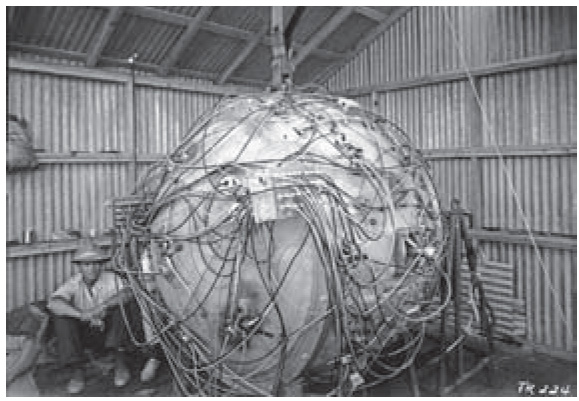One morning a few years back, I happened to be walking along South Ellis Avenue on the University of Chicago campus when I noticed a plaque marking the site where Enrico Fermi and Leó Szilárd and their colleagues achieved the world’s first nuclear chain reaction, on December 2, 1942, right there inside what were then the squash courts, tucked under the bleachers of the university’s Stagg Field. Drifting into a nearby building, I came upon a little commemorative display, including a drawing of the atomic pile itself, a remarkably makeshift-looking assemblage 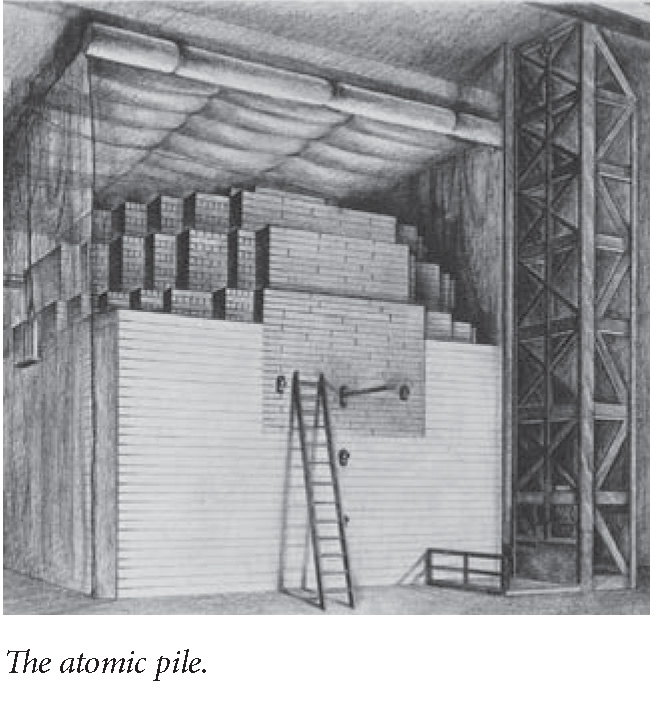 of graphite blocks housing uranium pellets which bore an uncanny resemblance to some sort of Babylonian temple from the times of Nebuchadrezzar (or, anyway, Indiana Jones’s approximation of same), and then, as well, a photograph of the Trinity device, direct descendant of that Chicago pile whose detonation in the New Mexico desert a mere two and a half years later, just as the sun was rising on the morning of July 16, 1945, signaled the astonishing triumph of the Manhattan Project and of course plunged mankind into a portentously new era all its own. (“Now I am become death, destroyer of worlds,” the project’s leader, J. Robert Oppenheimer, subsequently recalled thinking as he watched the mushroom cloud rising high into the blackened sky, famously invoking that harrowing line from the Hindu Bhagavad Gita.)
of graphite blocks housing uranium pellets which bore an uncanny resemblance to some sort of Babylonian temple from the times of Nebuchadrezzar (or, anyway, Indiana Jones’s approximation of same), and then, as well, a photograph of the Trinity device, direct descendant of that Chicago pile whose detonation in the New Mexico desert a mere two and a half years later, just as the sun was rising on the morning of July 16, 1945, signaled the astonishing triumph of the Manhattan Project and of course plunged mankind into a portentously new era all its own. (“Now I am become death, destroyer of worlds,” the project’s leader, J. Robert Oppenheimer, subsequently recalled thinking as he watched the mushroom cloud rising high into the blackened sky, famously invoking that harrowing line from the Hindu Bhagavad Gita.)
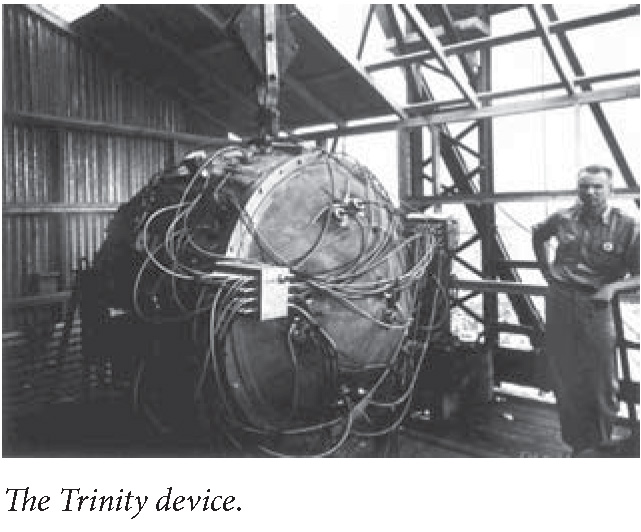
A few minutes later, and not a hundred yards farther along on my morning amble, I came upon the university’s storied Oriental Institute, no mean pile itself, and wandered on in.
On the spur of the moment I inquired of the receptionist whether my old pal the eminent Assyriologist Matthew Stolper might be around in his attic office upstairs, and as it turned out he was.
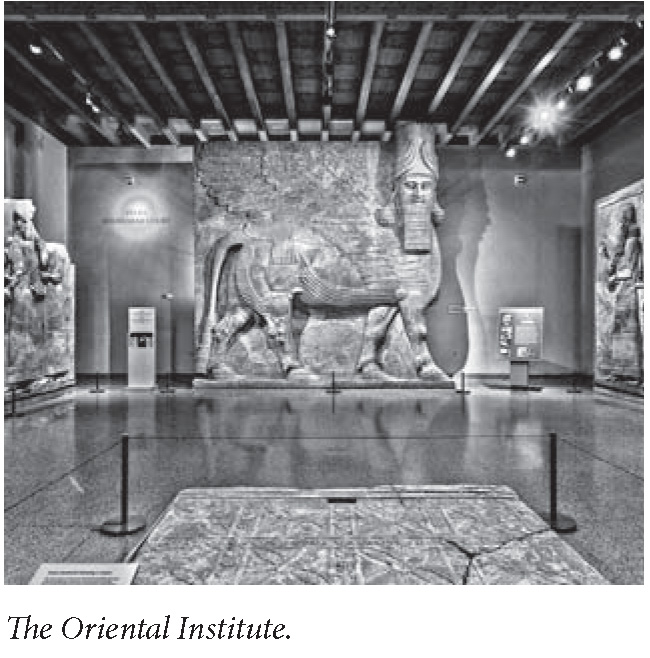
I’ve written about Professor Stolper before. He’s the fellow whose day (and night and weekend) job consists of methodically making his way, one instance at a time (and often for months at a time per instance), through the thousands upon thou-sands of Shredded Wheat–sized, chicken-scratch-festooned cunei-form clay tablets that make up the astonishing treasure trove that is the Persepolis Fortification Archive.
Originally gathered following a major discovery by archeaologists sent out from the Rockefeller-financed Oriental Institute near what is now Shiraz, in southwestern Iran (the find, as it happens, having first been reported on March 4, 1933, the very day of the inauguration, back in America, of President Franklin D. Roosevelt, who would go on to order the construction of the atom bomb in question, and just a week after the Reichstag fire, in Berlin, which Chancellor Hitler would use as his excuse for consolidating power, a situation whose horrible compounding consequences would come to form the rationale for Roosevelt’s own eventual order), the haul would turn out to offer a minutely detailed inventory of the inner workings of the imperial storehouses of the Achaemenid 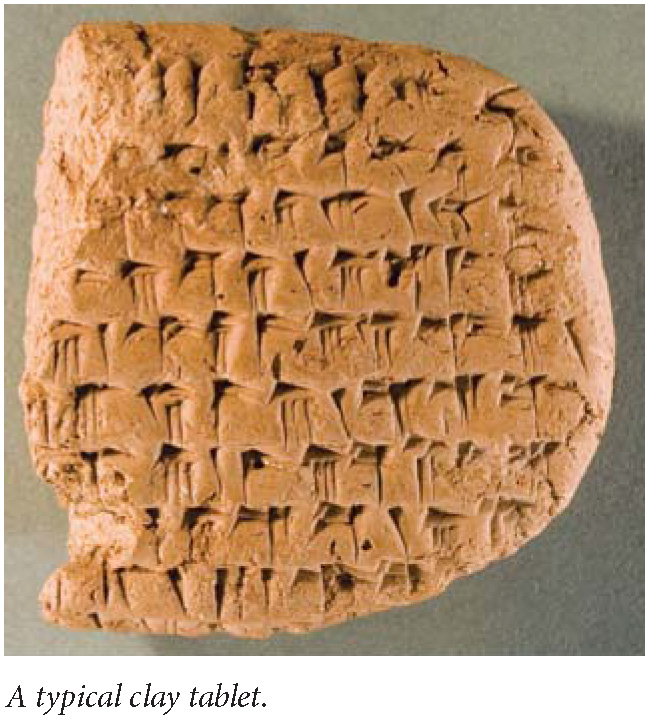 dynasts Darius and Xerxes (famed scourges, readers of Herodotus will recall, of the Attic Hellenes of the fifth century BCE). As such, any individual shard (all of which were presently transported on loan from the Iranian regime to the Oriental Institute in Chicago) might not prove that interesting in itself, though some, as Stolper never ceased delighting in relating, featured such delicious finds as tabulations on the amount of beer to be allocated to pregnant women during any given season, or the expense account of one of the Pony Express riders bringing back word of the imperial defeat at the Battle of Marathon. The true value of the trove, however, is the way that, taken as a whole, it affords an incredibly vivid sense of daily life as it was experienced at the heart of the vast Persian Empire in those days, and ever the more so with each new, painstakingly exacted translation. (Eighty years in, and the generations of successive Elamite and Aramaic language experts have still processed—which is to say cleaned, cataloged, translated, and published—only 2,100 of the well over 20,000 total tablets.) I was looking forward to hearing about the latest of Stolper’s discoveries.
dynasts Darius and Xerxes (famed scourges, readers of Herodotus will recall, of the Attic Hellenes of the fifth century BCE). As such, any individual shard (all of which were presently transported on loan from the Iranian regime to the Oriental Institute in Chicago) might not prove that interesting in itself, though some, as Stolper never ceased delighting in relating, featured such delicious finds as tabulations on the amount of beer to be allocated to pregnant women during any given season, or the expense account of one of the Pony Express riders bringing back word of the imperial defeat at the Battle of Marathon. The true value of the trove, however, is the way that, taken as a whole, it affords an incredibly vivid sense of daily life as it was experienced at the heart of the vast Persian Empire in those days, and ever the more so with each new, painstakingly exacted translation. (Eighty years in, and the generations of successive Elamite and Aramaic language experts have still processed—which is to say cleaned, cataloged, translated, and published—only 2,100 of the well over 20,000 total tablets.) I was looking forward to hearing about the latest of Stolper’s discoveries.
In the event, now that I’d made it up to his office, I found the good professor far from his normally ebullient self: indeed, he looked grimmer than I’d ever seen him, and with good reason, as now became evident. He went on to describe how the entire collection had suddenly and quite improbably become entangled in a veritably Dickensian lawsuit, and it was far from clear that the archive as such was even going to survive.
The story, as he proceeded to re-late it, was as follows. In 1997, five American tourists had been killed, and many others wounded, in a “terrorist” suitcase bombing of a Jerusalem shopping mall, an attack for which Hamas subsequently assumed responsibility. In 2001, in various US courts, the survivors of the attack and the families of the victims mounted a series of suits for damages against Hamas and the organization’s alleged sponsors in Iran (Iran didn’t even bother to show up for the trial), and the court presently awarded the plain-tiffs almost $400 million in damages in one case, and $2.6 billion in an-other. In 2004, lawyers for the plain-tiffs began suing a whole range of American institutions in order to ac-quire objects currently being held on behalf of various Iranian entities (as was the case with the entire Persepolis Fortification Archive, which had al-ways been destined for return to Iran following completion of that epic labor of translation and codification) so that the plaintiffs could in turn break up the resultant proceeds and sell them at auction in order to recoup their damages.
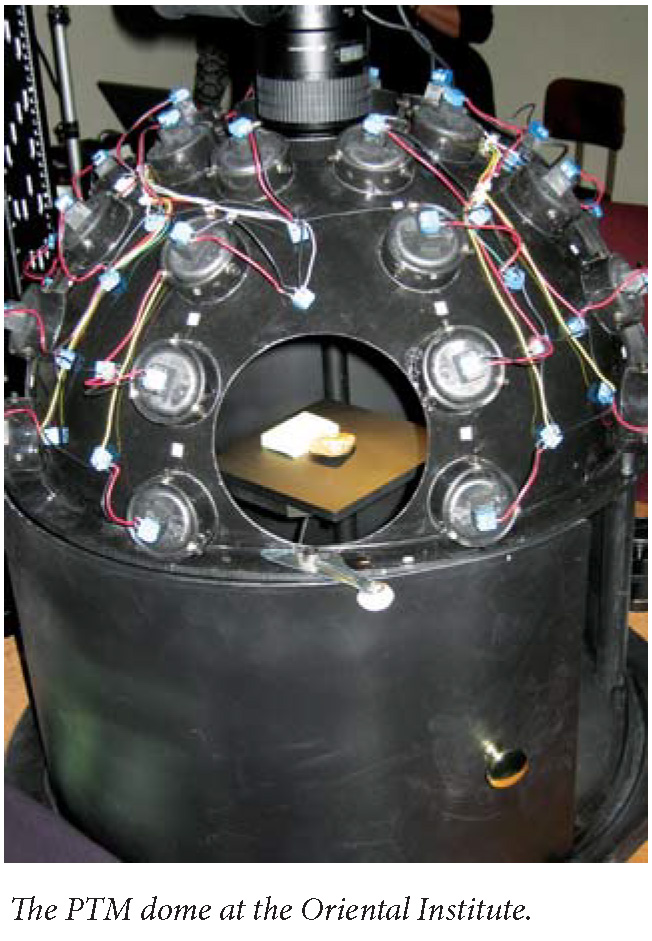
Stolper was appalled at this development. Setting aside the looming catastrophic prospect of breaking up a collection each of whose elements might be likened to a single bone, or even just a shard of bone, in what might otherwise someday come to be understood as an entire dinosaur skeleton, or indeed group of skeletons, the whole notion of using cultural artifacts on temporary international loan in this manner, as chess pieces in arcane politicized legal battles, foretokened dismal consequences for the fate of global scholarship as a whole. For that matter, the jig was going to be up with regards to the Persepolis Archive, no matter what. Even if, as was hoped, on the far side of years and years of litigation yet to come, the final decision ended up favoring the institute (and other such entities around the country), the Iranians had now be-come sensitized to the peculiarities, shall we say, of the American legal system, and the consequent precariousness of their own property rights in America, and were going to be demanding the earliest possible return of these remarkable instances of their cultural patrimony, such that the entire decades-long effort at interpreting this extraordinary horde had now itself come into dire jeopardy.
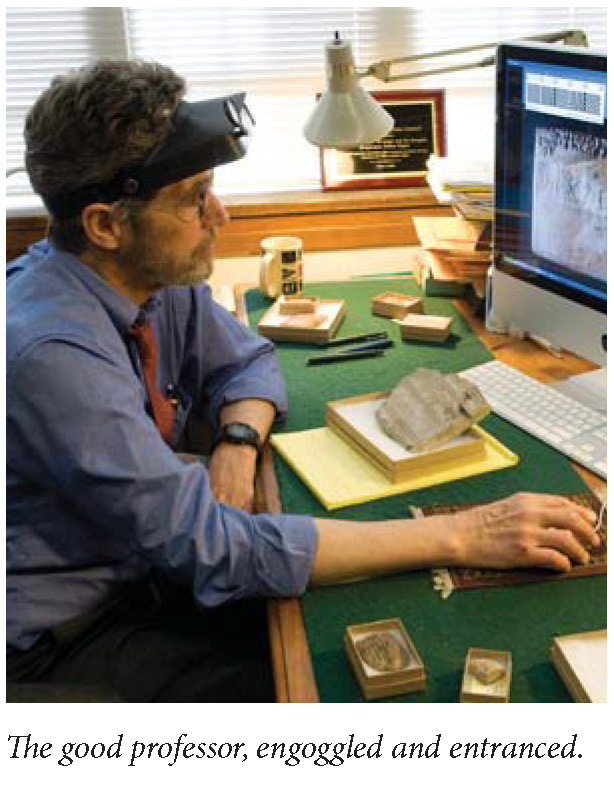
Why, I asked, couldn’t they just photograph all the untranslated tab-lets before either surrendering them to the plaintiffs or else sending them back to Iran?
At which point a smile broke over Stolper’s face for the first time that morning, the usual gleam re-turning to his eyes. “It’s not as simple as you would think,” he explained. “First you have to establish all sorts of things about each object, where they fit within the horde as a whole, then you have to clean and catalog them before you start trying to interpret their meaning, and in order to do that kind of interpretation, you re-ally need to be able to hold the object in your hand, shift it under the light so as to be able to catch the incredibly subtle details, which become visible only when you hold it this way or that. Individual photographs won’t do the job. But”—and now his smile grew wider still—“well, follow me. I think we’ve come up with a solution for that problem.”
We proceeded downstairs, negotiating a labyrinth of halls, to a little warren at the far back of the other side of the museum. He opened the door, and there, tucked in a corner, was the bomb from the Trinity explosion:
Well, OK, not that very bomb (presumably that one had been blasted to smithereens back on that 1945 morning), and not even a bomb at all, of course, but something that looked damn like the Trinity device, a black hemisphere all wrapped in nodes and wires. Only this one had a circular hole in its side and inside, on a little platform, was one of those clay cuneiform tablets.
The whole thing, known as the Polynomial Texture Mapping Dome (PTM), was wired to a nearby computer, and Stolper now proceeded to explain that the thirty-two nodes contained flash devices wired to go off in rapid-fire sequence, thereby allowing cameras to record first one side of the tablet, then (turn it over) the other side, in such a way that the computer would be able to stitch the resultant images into a 3-D-like approximation of the object, one that any researcher anywhere in the world could then manipulate on their own computer screen, zooming in or out, angling the image or its light source to the left or the right, whatever.
It occurred to me that the nodes and wires wrapped around the Oriental Institute device had functions not unlike those wound around its Trinity forebear, the latter, too, having consisted of an astonishment of lens-like contours and a meticulously timed sequence of mini explosions designed to concentrate the requisite energy onto that tablet of fissile material lodged at the heart of the device, enough to set off a far-grander version of the sort of atomic chain reaction that had first been glimpsed, two and a half years earlier, in that squash court just around the corner from this very institute.
Nor was I oblivious to the fact that the prospect of the Iranian regime’s inching toward a culmination of its own alleged Manhattan Project seemed to be very much on people’s minds these days (notwithstanding the fact that the only state in the region known to have any actual nu-clear weapons was Israel: talk about a balance of terror).
Anyway, the reason all this comes back to me just now is that I received word the other day that Professor Stolper is retiring from his aerie high atop the Oriental Institute (though he will stay engaged in the Persepolis documentation project). I decided to call him up, see how things were going, and he informed me that though the legal case itself continues to stagger endlessly along, the photo-imaging team has managed to record copies of more than 4,700 of the remaining tablets (copies that even you can access: just go to inscriptifact.com, download the requisite app, and start cracking!). Truly, a lemon-laced scholarly ambrosia, wrested from the bitter lemons of judicial misprision.

